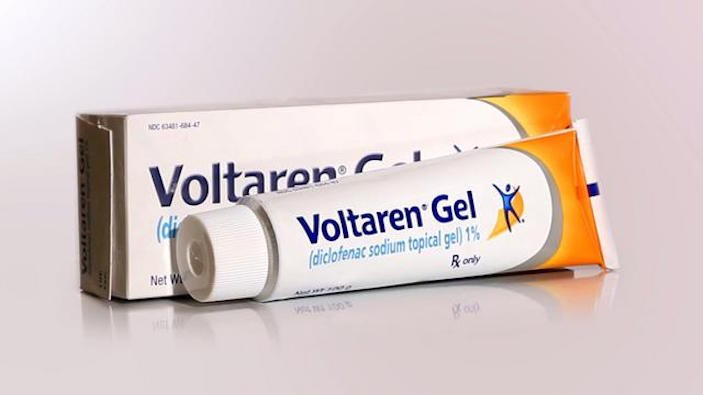Oral NSAIDs are a mainstay for the treatment of low back pain, osteoarthritis, and other acute and chronic musculoskeletal complaints. However, concern for side effects like GI bleeding, GI upset, and nephropathy limit their use. Topical NSAIDs can provide many of the same benefits as oral NSAIDs, with potentially fewer risks.
Notable History:
NSAIDs, such as aspirin precursors, have been used for millennia. Myrtle leaves and willow bark both contain salicin, an aspirin precursor, and have been used for their anti-pyretic and analgesic properties. Propionic acid derivatives like ibuprofen have been available over the counter in the US since the 1980s. Over 30 billion doses of NSAIDs are sold over the counter yearly in the United States, and NSAIDs account for over 70 million prescriptions [1].
Recently In the news for:
The Cochrane collaboration recently reviewed the effectiveness of topical NSAIDs for prolonged treatment (8 weeks or more) of osteoarthritis. Topical NSAIDs were found to be as effective as oral NSAIDs for pain relief (NNT for 50% pain relief was 6.4 for topical solution, 11 for topical gel). Adverse GI side effects were less common with the topical than with oral NSAIDs, and occurred at a rate comparable to placebo [2]. Another Cochrane review analyzed studies of topical NSAIDs for lateral elbow pain and found fewer GI side effects with topical NSAIDs [3]. However, the studies were small and data was of generally poor quality. A third recent Cochrane review examined use of topical NSAIDs for acute pain, with treatment durations of 1-2 weeks, and found the NNT for 50% reduction of pain was 4.5 [4]. Unfortunately, the risk of renal injury with topical NSAIDs has not been clearly defined. Case reports have noted renal impairment after topical NSAID use, [5] though the amount of systemic absorption (6-10%) [6] is considerably less than with oral NSAIDs (85%) [7].
How it works:
NSAIDs inhibit cyclooxygenase I and II enzymes, thereby inhibiting synthesis of prostaglandins and thromboxane. They have analgesic, anti-pyretic, and anti-inflammatory effects.
Major indications:
Diclofenac gel (Voltaren), is commonly used for acute or chronic musculoskeletal pain. It is applied directly to the site of pain on the skin, back, or joint. The diclofenac solution (Pennsaid) is approved for use in osteoarthritis of the knee.
Adverse Events:
The main adverse event noted for topical NSAIDs is the risk of a mild rash at the site of application, which does not generally preclude use. Renal, GI, and cardiovascular risks are likely lower than with oral NSAIDs, though good data on rates of these side effects are lacking.
Cautions:
All NSAIDs carry black box warnings for the risk of serious cardiovascular and thrombotic events such as myocardial infarction and stroke. They also carry a warning for the risk of serious GI events such as bleeding, ulceration, and perforation.
 DOSING & Adjustments:
DOSING & Adjustments:
1% Diclofenac gel (Voltaren) is typically applied four times daily to the affected area, up to 32g/day total. The 1.5% diclofenac solution (Pennsaid) is used for osteoarthritis of the knee, with 40 drops per knee four times daily. It should not be applied to skin that is infected, broken, or inflamed.
Special considerations:
NSAIDs are not recommended in pregnancy, particularly in the 3rd trimester, when they may cause premature closure of the ductus arteriosus. They are class C during earlier pregnancy, and class D during 3rd trimester.
Cost:
A 100g tube of 1% diclofenac gel costs around $45 [6]. 150mL of the 1.5% solution costs close to $260. Some insurance plans require additional physician authorization before allowing patients to fill these prescriptions.
REFERENCES
1. Green GA. Understanding NSAIDs: From aspirin to COX-2. Clin Cornerstone. 2001;3(5):50-60.
2. Derry S, Moore RA, Rabbie R. Topical NSAIDs for chronic musculoskeletal pain in adults. Cochrane Database Syst Rev. 2012;9
3. Pattanittum P, Turner T, Green S, Buchbinder R. Non-steroidal anti-inflammatory drugs (NSAIDs) for treating lateral elbow pain in adults. Cochrane Database Syst Rev. 2013;5
4. Massey T, Derry S, Moore RA, McQuay HJ. Topical NSAIDs for acute pain in adults. Cochrane Database Syst Rev. 2010;(6):CD007402. doi(6)
5. Andrews PA, Sampson SA. Topical non-steroidal drugs are systemically absorbed and may cause renal disease. Nephrol Dial Transplant. 1999;14(1):187-189.
6. Lexicomp Online. Diclofenac (topical): Drug information. UptoDate Web site. uptodate.com. Accessed 01/20, 2015.
7. Lexicomp Online. Ibuprofen: Drug information. UptoDate Web site. uptodate.com. Accessed 01/20, 2015.




3 Comments
I perform 2nd and 3rd level review for insurance denials, and have seen this medication denied numerous times for back pain. Many insurance companies limit their coverage of prescriptions to the FDA approved indications. In the case of Diclofenac (Voltaren):
“VOLTAREN® GEL is indicated for the relief of the pain of osteoarthritis of joints amenable to topical treatment, such as the knees and those of the hands.
VOLTAREN® GEL has not been evaluated for use on the spine, hip, or shoulder.
As such, some insurance companies will pair the ICD-9 code and reject coverage for back pain or other off label locations.
I believe that Voltaren is dangerous. I am slowly dying from three applications of extra strength in March of 2016 to treat tennis elbow.
There are other otc topical NSAID pain relievers like Aspirin Cream.
It is very effective too.
https://www.AspirinCream.com